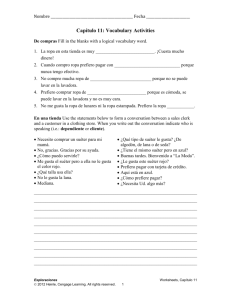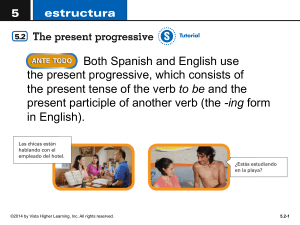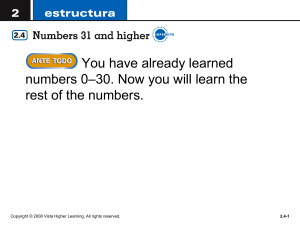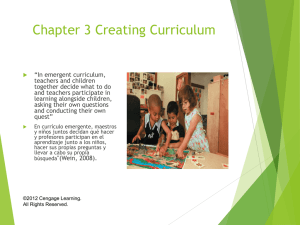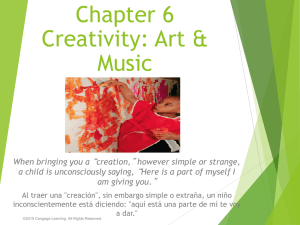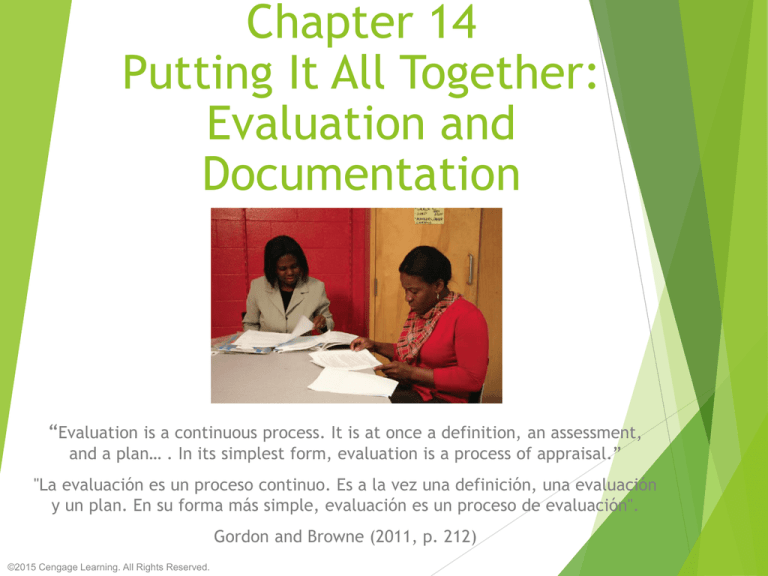
Chapter 14
Putting It All Together:
Evaluation and
Documentation
“Evaluation is a continuous process. It is at once a definition, an assessment,
and a plan… . In its simplest form, evaluation is a process of appraisal.”
"La evaluación es un proceso continuo. Es a la vez una definición, una evaluación
y un plan. En su forma más simple, evaluación es un proceso de evaluación".
Gordon and Browne (2011, p. 212)
©2015 Cengage Learning. All Rights Reserved.
Evaluation Defined
Evaluation is the process of determining
whether the philosophy, goals, and
objectives of the program have been met
La evaluación es el proceso de determinar si
se ha cumplido la filosofía, metas, y los
objetivos del programa
Assessment and evaluation are closely
related and can happen simultaneously
Valoración y evaluación están
estrechamente relacionados y pueden
ocurrir simultáneamente
©2015 Cengage Learning. All Rights Reserved.
Evaluation Defined
Ongoing evaluation is part of the
curriculum process
Evaluación continua es parte del proceso de
plan de estudios
Informal and formal evaluation of a
program should include the indoor and
outdoor environments, schedule, routines,
the curriculum as a whole, themes, lesson
plans, activities, performances of the
children, and the teacher’s role
©2015 Cengage Learning. All Rights Reserved.
Evaluation Defined
Evaluaciones informales y formales de un
programa deben incluir los ambientes interiores y
exteriores, horarios, rutinas, el currículo como un
todo, temas, planes de lecciones, actividades,
actuaciones de los niños y el papel del maestro
Evaluation provides feedback concerning the
effectiveness of the program, the goals and
objectives, the teaching approach, the
observation cycle, and the evaluation process
itself
Evaluación proporciona retroalimentación sobre la
efectividad del programa, las metas y objetivos,
el enfoque de la enseñanza, el ciclo de
observación y el propio proceso de evaluación
©2015 Cengage Learning. All Rights Reserved.
Beginning the
Evaluation Process
What is the purpose of the
evaluation?
¿Quién usará la
información?
¿Cómo usarán la
información?
What questions will the
evaluation seek to answer?
¿Qué preguntas la
evaluación intentará
responder?
©2015 Cengage Learning. All Rights Reserved.
When are the results needed?
What’s your time line?
¿Cuándo se necesitan los
resultados? ¿Cuál es tu
tiempo?
What are your own abilities
and skills? Are there others
who can help?
How will they use the
information?
¿Cuál es el propósito de la
evaluación?
Who will use the
information?
¿Cuáles son sus propias
habilidades y destrezas? ¿Hay
otros que pueden ayudar?
What resources do you have
or can you access (time,
money, and people)?
¿Qué recursos tienes o
puedes acceder (tiempo,
dinero y personas).
Quantitative and
Qualitative Evaluation
Quantitative methods
used to evaluate
programs
Métodos cuantitativos
utilizados para evaluar
los programas
Focus groups
Interviews
Surveys
Review of records
Observations
Direct testing
Grupos de enfoque,
entrevistas,
encuestas, revisión
de documentos,
observaciones,
pruebas directas
Qualitative measures focus on
results of services for children
and families, such as
Las medidas cualitativas se
centran en resultados de
servicios para niños y familias,
tales como
Developmental and early
learning outcomes
Family involvement
Calificaciones del entorno
físico
Satisfaction with services
©2015 Cengage Learning. All Rights Reserved.
Participación de la familia
Ratings of the physical
environment
Primeros resultados del
aprendizaje y de desarrollo
Satisfacción de servicios
Formative Evaluation
A method for judging the worth of a program
or project while the program activities are
forming or in progress
Un método para juzgar el valor de un
programa o proyecto, mientras que las
actividades del programa se están formando o
en curso
Primarily a building process of collecting
information over time to help you improve
your program
Principalmente un proceso de construcción de
colectar información atreves del tiempo para
ayudarle a mejorar su programa
©2015 Cengage Learning. All Rights Reserved.
Formative Evaluation
Used to monitor how well the program goals and
objectives are being met
Main purpose is to catch deficiencies so that the
proper interventions can take place that improve
program outcomes
Utilizado para controlar qué tan bien se están
cumpliendo las metas del programa y objetivos
Principal objetivo es atrapar las deficiencias para
que las intervenciones adecuadas pueden llevarse a
cabo que mejoren los resultados del programa
Formative evaluation is also useful in analyzing
learning materials, curriculum, and teacher
effectiveness
Evaluación formativa también es útil en el análisis
de materiales de enseñanza, currículo y efectividad
del maestro
©2015 Cengage Learning. All Rights Reserved.
Summative Evaluation
Method of judging the worth of a program at the end of
program activities or a specific time period
Used in accreditation studies to see how a program
measures up using the accreditation standards and criteria
Utilizado en estudios de acreditación para ver cómo un
programa de medidas utilizando los criterios y estándares de
acreditación
Might also be used to determine how well children in a
program do in meeting the learning goals set out for them
Método de juzgar el valor de un programa al final de las
actividades del programa o un período de tiempo específico
También puede utilizarse para determinar cómo los niños en un
programa en cumplir los objetivos de aprendizaje establecidos
para ellos
Focus is on outcome
El enfoque son los resultado
©2015 Cengage Learning. All Rights Reserved.
Evaluation Standards
Developmentally Appropriate Practice in
Early Childhood Programs, 3rd Edition
NAEYC Early Childhood Program Standards
and Accreditation Criteria
Prácticas apropiadas en los programas de
niñez temprana, 3ª edición
NAEYC primera infancia programa
estándares y criterios de acreditación
Advancing the Early Childhood Profession:
NAEYC Standards and Guidelines for
Professional Development
©2015 Cengage Learning. All Rights Reserved.
Evaluation Standards
Hacer avanzar la profesión de la primera
infancia: NAEYC normas y directrices para
el desarrollo profesional
DEC Recommended Practices: A
Comprehensive Guide for Practical
Application in Early Intervention/Early
Childhood Special Education
DEC prácticas recomendada: Una completa
guía para aplicación práctica en temprana
intervención/especial educación infantil
©2015 Cengage Learning. All Rights Reserved.
Evaluation Standards
Common Core State Standards & QRIS
InTASC Model Core Teaching Standards
State Pre-Kindergarten Curriculum
Guidelines
Professional Educator Curriculum
Standards
Head Start/Early Head Start Performance
Standards
©2015 Cengage Learning. All Rights Reserved.
Reflect on This...
Why do you think the use of standards has
become so important?
¿Por qué crees que el uso de estándares se
ha convertido en algo tan importante?
©2015 Cengage Learning. All Rights Reserved.
Ethical Issues
Objectivity
Obtaining and using facts, information, or
data without distortion by personal feelings,
beliefs, or prejudgment
Objetividad:
obtención y utilización de datos,
información o datos sin distorsión por
prejuicios, creencias o sentimientos
personales
Reliability
Extent to which any evaluation technique
yields results that are accurate and
consistent over time
©2015 Cengage Learning. All Rights Reserved.
Ethical Issues
Inter-rater reliability refers to when different
people use the same evaluation tool or
technique and get the same results with few
exceptions
Grado
de fiabilidad: que cualquier técnica de
evaluación produce resultados que son
precisos y coherentes sobre tiempo y fiabilidad
Inter rater se refiere a cuando diferentes
personas usan la misma herramienta de
evaluación o la técnica y obtienen los mismos
resultados con pocas excepciones
©2015 Cengage Learning. All Rights Reserved.
Ethical Issues
Validity
Extent to which any evaluation technique
fulfills the purpose for which it is intended
Grado
de validez a que cualquier evaluación
técnica cumple el propósito para el cual se
pretende
Bias
In evaluation refers to a test, process,
procedure or use of the results that unfairly
discriminates against one individual or group
in favor of another
Prejuicio: en la evaluación se refiere a una prueba,
proceso, procedimiento o utilización de los resultados que
discrimina injustamente a un individuo o grupo a favor de
©2015 Cengage Learning.
otroAll Rights Reserved.
Methods of Evaluation
Questionnaires
Surveys
Interviews
Focus groups
Observations
Portfolios
Cuestionarios,
encuestas,
entrevistas,
grupos de
enfoque, carpetas
de observaciones
©2015 Cengage Learning. All Rights Reserved.
Checklist
Rating Scale
Anecdotal record
Event sampling or
frequency count
Time sample
Lista de
verificación,
escala de
clasificación,
anecdótico récord,
evento muestra o
conteo de
frecuencia,
muestra de tiempo
Portfolio Assessment
Systematic collection of information
gathered over time from all available
sources
Colección sistemática de la información
recopilada en el tiempo de todas las fuentes
disponibles
Can be about a child’s ongoing development
and the child’s work gathered by both the
child and teacher or a classroom or program
Puede ser sobre desarrollo infantil y el
trabajo del niño reunidos por tanto al niño y
maestro o un aula o programa
©2015 Cengage Learning. All Rights Reserved.
Portfolio Assessment
Classroom portfolio is a collection of childand teacher-produced material and product
samples showing a program’s strengths
related to set of criteria such as the NAEYC
Children’s Program Accreditation Standards
Portafolio de aula es una colección de niño y
maestro-producido materiales y muestras
demostrando las fortalezas del programa
relacionados con el conjunto de criterios
tales como estándares de acreditación de la
NAEYC infantiles Programa
©2015 Cengage Learning. All Rights Reserved.
Portfolio (Continued)
Includes samples of a child’s self-initiated
“work” in art or other curriculum area;
photographs, audio and video tapes;
program objectives, observations and
anecdotal records, programmatic and
environmental checklists; and family surveys
and comments
Incluye muestras de un niño auto-iniciado
"trabajo" en arte o en otra área curricular;
fotografías, cintas de audio y video; los
objetivos del programa, observaciones y
anecdóticos, listas de control programáticos y
ambientales; y las encuestas familiares y
comentarios
©2015 Cengage Learning. All Rights Reserved.
Portfolio (Continued)
Creative means of organizing, summarizing,
and sharing artifacts, information, and ideas
about teaching or learning, along with
personal and professional growth
Medios creativos de organizar, resumir y
compartir ideas sobre la enseñanza o el
aprendizaje, junto con el crecimiento
personal y profesional, información y
artefactos
©2015 Cengage Learning. All Rights Reserved.
Portfolio (Continued)
The reflective process of portfolio
development can be as important as the
final product
El proceso reflexivo de portafolio desarrollo
puede ser tan importante como el producto
final
A portfolio is a sampling of the breadth and
depth of a child’s, teacher’s, or program’s
work conveying the range of abilities,
attitudes, experiences, and achievements
Un portafolio es una muestra de la amplitud y
profundidad de un niño, maestro o trabajo
del programa el rango de habilidades,
actitudes, experiencias y logros de transporte
©2015 Cengage Learning. All Rights Reserved.
Frequently Used EC
Evaluation Instruments
Classroom Assessment Scoring System
(CLASS)
Early Childhood Environmental Rating Scale
Revised Edition (ECERS-R)
Early Childhood Classroom Observation
Measure (ECCOM), D. Stipek and P. Byler
Early Language and Literacy Classroom
Observation Tool (ELLCO)
©2015 Cengage Learning. All Rights Reserved.
Frequently Used EC
Evaluation Instruments
Infant Toddler Environment Rating Scale
Revised Edition (ITERS-R)
School Age Care Environment Rating Scale
(SACERS)
Supports for Early Literacy Assessment
(SELA)
©2015 Cengage Learning. All Rights Reserved.
Recommended Practices
Program goals provide the best starting
point
Metas del programa proporcionan el mejor
punto de partida
Goals determine what the desired outcomes
are, which will then guide selection of
evaluation and accountability measures
Objetivos
determinan cuáles son los resultados
deseados, que guiará selección de medidas de
evaluación y rendición de cuentas
©2015 Cengage Learning. All Rights Reserved.
Recommended Practices
Collecting objective input from multiple
perspectives including parents, providers,
administrators, community partners, and
children themselves (when appropriate) will
ensure that program evaluation data are
objective and representative
Coleccionismo objetivo de entrada desde
múltiples perspectivas, incluyendo a los
padres, proveedores, administradores, socios
de la comunidad y ellos mismos (cuando
corresponda) se asegurarán de que son datos
de la evaluación del programa objetivo y
representante
©2015 Cengage Learning. All Rights Reserved.
Recommended Practices
Best results of program evaluation, either
negative or positive, are those that are used
to maintain and improve effective service
delivery
Los mejores resultados de la evaluación del programa, ya sea
negativo o positivo, son aquellos que se utilizan para
mantener y mejorar la prestación de servicios efectivos
©2015 Cengage Learning. All Rights Reserved.
Interpreting and Using
Evaluation Results
Before information can be interpreted, it is
important to ask yourself several questions:
Antes de que la información pueda ser
interpretada, es importante hacerse varias
preguntas:
Are there enough samples?
¿Hay
suficientes muestras?
Have you collected enough information over
time to see change or is this a one time
observation?
¿Se
ha recogido suficiente información a traves
del tiempo para ver cambiar o esto es una
observación de tiempo?
©2015 Cengage Learning. All Rights Reserved.
Interpreting and Using
Evaluation Results
Has something occurred on the time of the
assessment that could affect the results?
Algo
ha ocurrido en el momento de la
evaluación que podría afectar los resultados.
Are the assessment tools you used valid
instruments?
¿Son
las herramientas de evaluación que
utilizó instrumentos válidos?
©2015 Cengage Learning. All Rights Reserved.
Rubrics
Use rubrics to assess children’s level of
functioning, staff performance, curriculum,
or program standards
Utilizar rúbricas para evaluar el nivel de los
niños de funcionamiento, rendimiento del
personal, currículo o las normas del programa
Rubrics are charts that identify different
levels and qualities of attainment of each
benchmark or standard
Rúbricas son cartas que identifican a
diferentes niveles y calidades de logro de
cada referencia o estándar
©2015 Cengage Learning. All Rights Reserved.
Rubrics
Presents rules or guidelines by which a
complex performance can be judged
Presenta las normas o directrices por el cual
se puede juzgar un funcionamiento complejo
©2015 Cengage Learning. All Rights Reserved.
Use of Evaluation Data
Determining how to use assessment information does
take time and isn’t a one-time process
Determinar cómo utilizar la información de
evaluación toma tiempo y no es un proceso único
You can start by reflecting on what do to with the
evaluation results
Puedes empezar por reflexionar sobre qué hacer
con los resultados de la evaluación
Then make a plan for continued data collection,
interpretation, and change
Entonces
hacer un plan continuo de recogida
de datos, interpretación y cambiar
©2015 Cengage Learning. All Rights Reserved.
Use of Evaluation Data
Make sure to balance what you might like to
change with what is possible
Asegúrate de equilibrar lo que te gustaría
cambiar con lo que es posible
Then implement your plans for change.
Implementar
sus planes para el cambio.
Your plan will be individualized because each
child and program is unique
Su plan será ser individualizado porque el
programa y cada niño son único
©2015 Cengage Learning. All Rights Reserved.
Use of Evaluation Data
Assessing and interpreting evaluation
information is an ongoing process and
determining uses for the information should
also be ongoing
Evaluar e interpretación de la información es
un proceso continuo de evaluación y
determinación de usos de la información
también deben ser continuos
©2015 Cengage Learning. All Rights Reserved.
Documentation
An effective piece of documentation tells the story and the
purpose of an event, experience, or development. It is a product
that draws others into the experience—evidence or artifacts that
describe a situation, tell a story, and help the viewer to
understand the purpose of the action.
Una pieza de documentación eficaz narra la historia y el
propósito de un evento, experiencia o desarrollo. Es un
producto que otros se basa en la experiencia — evidencia o
artefactos que describen una situación, un cuento y ayudar al
espectador a entender el propósito de la acción.
©2015 Cengage Learning. All Rights Reserved.
(Seitz, 2008, p. 88).
Ask these Questions
Why are you wanting to collection
information?
¿Por qué quieres información recogida?
Who are you documenting information for?
¿Para quién estas documentando la
información?
Where to document? (¿Dónde documento?)
When to document? (¿Cuándo debe
documentar?)
How to document? (¿Cómo documentar?)
©2015 Cengage Learning. All Rights Reserved.
Documentation Boards
Used to make learning visible and teaching
intentional
Solía hacer aprendizaje visible y enseñanza
intencional
Documentation typically includes:
La documentación típicamente incluye:
Samples of a child’s work at several different
stages of completion
Muestras
del trabajo de un niño en varias
etapas diferentes de terminación
Photographs showing work in progress
Fotografías
©2015 Cengage Learning. All Rights Reserved.
muestran trabajos en curso
Documentation Boards
Comments written by the teacher
Comentarios
escritos por el maestro
Transcriptions of children’s discussions
Transcripciones
de conversaciones de los niños
Comments and explanations of intentions
about the activity
Comentarios
y explicaciones de intenciones
sobre la actividad
Comments made by parents
Comentarios
©2015 Cengage Learning. All Rights Reserved.
hechos por los padres
Documentation Boards
(continued)
They can also contain photographs of
children participating in a particular activity
También pueden contener las fotografías de
los niños que participan en una actividad en
particular
©2015 Cengage Learning. All Rights Reserved.
Uses of
Documentation Boards
Everything included in a
documentation board is done so
for a reason
Can be used to scaffold learning
opportunities so they can
progress smoothly to the next
stage in their development
Todo incluido en un tablero de
documentación es hecho por
una razón
Se puede utilizar para las
oportunidades de aprendizaje
del andamio así que puede
progresar sin problemas a la
siguiente etapa en su desarrollo
Teachers can also use them to
evaluate their own teaching
practices
Los maestros también pueden
utilizar para evaluar sus propias
prácticas de enseñanza
©2015 Cengage Learning. All Rights Reserved.
Objective Recording
Guidelines
Record only the facts
Record every detail
Registrar sólo los hechos
Registra cada detalle
Do not interpret while you observe
No interpretan mientras observas
Do not record what you do not see
Use objective words
Usa palabras objetivas
Record the facts in order
©2015 Cengage Learning. All Rights Reserved.
Objective Recording
Guidelines
Date your entries or work samples
Registrar los hechos en orden
Pon fechas a sus entradas o muestras de
trabajo
Keep your entries short
Mantener las entradas cortas
©2015 Cengage Learning. All Rights Reserved.
Authentic Documentation
of Learning Takes…
Practice to remember to take photos of
children’s engagements and work
Organization of ways to save authentic work
and representations
Practique para acordarse de tomar fotos de las
contrataciones de los niños y trabajar
Organización de formas de ahorrar las
representaciones y auténtica obra
Finding time to record conversations or
anecdotal notes
Encontrar tiempo para grabar las
conversaciones o notas anecdóticas
©2015 Cengage Learning. All Rights Reserved.
Authentic Documentation
of Learning Takes…
Commitment to keep documentation current
and relevant to recent interests and
investigations
Compromiso de mantener la documentación
actual y relevante para las investigaciones y
los últimos intereses
©2015 Cengage Learning. All Rights Reserved.
Using Technology to
Document
Documentation can come in many forms
Documentación puede venir en muchas formas
The more technology that comes available to
us at more and more affordable rates, the
easier it becomes to create more realistic
portrayals of our work
La tecnología que esta más disponible para
nosotros a precios más asequibles, resulta más
fácil crear representaciones más realistas de
nuestro trabajo
©2015 Cengage Learning. All Rights Reserved.
Using Technology to
Document
Using this form of documentation can reduce
the amount of space taken up previously by
traditional hand-written documentation
Usando este formulario de documentación
puede reducir la cantidad de espacio ocupado
anteriormente por documentación escrita a
mano tradicional
©2015 Cengage Learning. All Rights Reserved.

